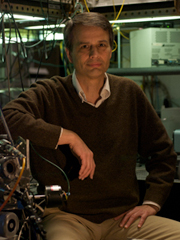Space-time analogies in electromagnetics: There is an intriguing analogy between the equations that describe the natural diffraction of electromagnetic wave in space and the spreading or dispersion of electromagnetic pulses in dielectrics. The mathematical analogy between these equations has led our group to develop the time domain analog of spatial lenses. These so-called “time lenses” allow us to manipulate optical waveforms in the time domain in much the same way that spatial imaging with conventional lenses is performed. For example, we have recently demonstrated a time microscope which can expand optical pulse trains by a factor of 100 which makes subpicosecond phenomena observable on a commercial high-speed oscilloscope. This technique may someday find applications in pushing the data rate of high speed fiber optic elecommunications systems.
Terahertz spectroscopy: Far above the frequency range of microwave signals is a portion of the spectrum where electromagnetic waves interact with complex molecules. This region, from roughly 100 Ghz to 100 THz, is difficult to access with conventional technology but recent advances using femtosecond light pulses has made it available for study in the laboratory and even on a small commercial scale. Briefly, intense femtosecond light pulses in the visible portion of the spectrum are focused into crystals, which react strongly with the intense optical field and reradiate pulses in the terahertz region with equally short duration and hence very large bandwidths. In effect, the process instantaneously covers a large portion of the spectrum in a very short electromagnetic pulse. We are creating systems to generate and detect these pulses and use them to study the interaction of the radiation with various materials. Generically, this is called spectroscopy and we are interested in the vast region of frequencies between microwaves and the near infrared.
Lasers as clocks: Modern femtosecond pulsed lasers have demonstrated extraordinary stability in the repetition rate of the pulse train. These lasers typically generate pulses of 20 femtoseconds at rates around 100 MHz. If the repetition rate were absolutely constant, these lasers could act as clocks by turning the optical pulses into electrical pulses with phodetectors. However, like any real oscillator (electrical, mechanical, optical, atomic), the repetition rate fluctuates and this deviation from the ideal is known as “phase noise.” We have assembled a system for studying the phase noise of femtosecond lasers that is quite possibly the best in the world in the sense that it can detect the most minute fluctuations in the timing stability right down to the quantum limit. We have recently used this system to characterize the stability of several optical and electronic oscillators and have found that our femtosecond lasers have remarkably low phase noise, even rivaling the best electronic oscillators. This suggests that femtosecond lasers, with further development, might make practical alternatives to quartz electronic oscillators for special applications in frequency and time keeping metrology.





